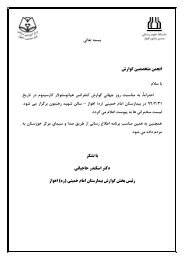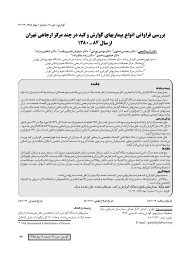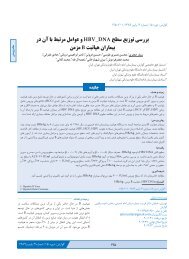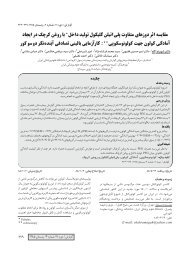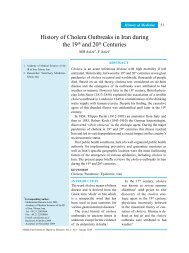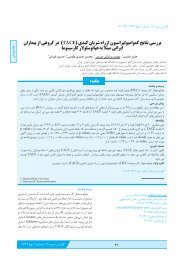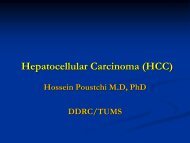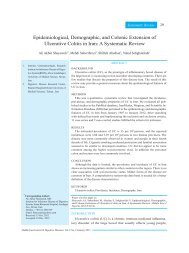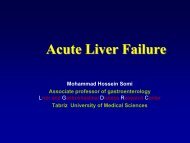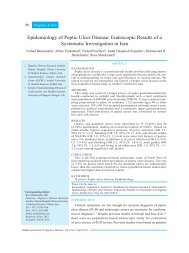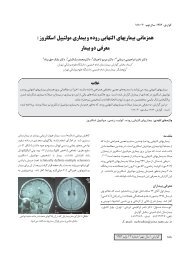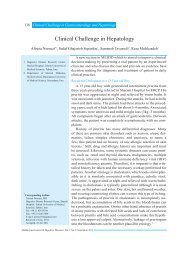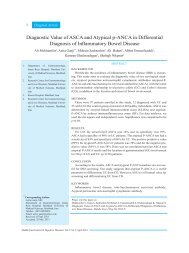Gallbladder Stones - IAGH
Gallbladder Stones - IAGH
Gallbladder Stones - IAGH
Create successful ePaper yourself
Turn your PDF publications into a flip-book with our unique Google optimized e-Paper software.
GALLSTONE:<br />
DIAGNOSIS AND TREATMENT<br />
Bijan Shahbazkhani<br />
Imam Khomeini hospital
CLINICAL MANIFESTATIONS OF<br />
GALLSTONES<br />
Asymptomatic Gallstones<br />
Symptomatic Gallstons<br />
• Biliary Colic<br />
• Acute Cholecystitis<br />
• Choledocholithiasis<br />
• Acute Cholangitis<br />
Complications
DIAGNOSTIC EVALUATION<br />
Laboratory Evaluation<br />
Imaging<br />
• Abdominal radiographs<br />
• Trans-abdominal Ultrasound<br />
• Nuclear Medicine (HIDA scan)<br />
• Magnetic Resonance Imaging (MRC/MRCP)<br />
• Endoscopic Ultrasound (EUS)<br />
• Endoscopic Retrograde Cholangiopancreatography (ERCP)<br />
• CT scan
IMPORTANT LABS<br />
Infection<br />
• WBC<br />
• Blood Cultures<br />
Hepatocyte inflammation and injury<br />
• AST/ALT<br />
Biliary Obstruction and Cholangiocyte injury<br />
• Total Bilirubin<br />
• Alkaline Phosphatase<br />
Gallstone Pancreatitis<br />
• Amylase (salivary, bowel)<br />
• Lipase (more specific to pancreas)
LABORATORY INTERPRETATION<br />
Acute Cholecystitis<br />
• WBC < 15<br />
• AST and ALT 2-3 x’s normal<br />
• Total Bilirubin < 4<br />
• Alk Phos mildly elevated<br />
Cholangitis<br />
• WBC > 15<br />
• Significant AST/ALT elevation<br />
• Total Bilirubin > 4<br />
• Modest elevation Alk-Phos<br />
Choledocholithiasis<br />
• Normal labs unless stone<br />
impaction<br />
• When obstruction occurs labs<br />
reflect either cholangitis,<br />
pancreatitis or both<br />
Gallstone Pancreatitis<br />
• Elevated WBC<br />
• Elevated lipase and amylase<br />
• Concomitant biliary obstruction<br />
Biliary Colic<br />
• Normal labs
ABDOMINAL RADIOGRAPHS<br />
Abdominal series:<br />
• supine, upright, decubitus and upright CXR<br />
Low sensitivity and specificity for stones<br />
Aid in the differential diagnosis<br />
Calcification in pancreatitis<br />
Ileus<br />
Perforation<br />
Intestinal pneumotosis<br />
Pneumonia
A plain abdominal x-ray showing calcified gallstones in the<br />
gallbladder (GB), cystic duct (CD) and common bile duct (CBD).
ULTRASOUND<br />
Initial diagnostic imaging modality of choice<br />
• 95% sensitivity for gallbladder stones >2 mm<br />
> 95% specificity with the post-acoustic shadow<br />
Quick<br />
Non-invasive<br />
Useful in the diagnosis of cholelithiasis, cholecystitis,<br />
choledocholithiasis, cholangitis<br />
Accurate<br />
Evaluates both hepatic, biliary and GB anatomy
Ultrasound images of a gallbladder adenomatous polyp (left panel arrowhead)<br />
compared to a gallstone (right panel arrowhead). Note the shadow cast by the<br />
stone (red arrow) compared to the absence of a shadow behind the polyp.
ULTRASOUND OF GALLSTONES
ULTRASOUND<br />
Acute Cholecystitis<br />
• Pericholecystic fluid and/or stranding<br />
• Thickened gall bladder wall<br />
• Intramural gas<br />
• Cholelithiasis and/or GB sludge<br />
• Sonographic Murphy’s sign - PPV >90%<br />
Choledocholithiasis<br />
• Extrahepatic stone localization<br />
• Sensitivity 50% - Common Bile Duct stones<br />
• Sensitivity 75% - dilated CBD<br />
> 6 mm intact gallbladder<br />
>10 mm post-cholecystectomy
CHOLESCINTIGRAPHY (HIDA)<br />
Useful if the Ultrasound is non-diagnostic<br />
A positive HIDA-scan for acute cholecystitis:<br />
normal uptake of HIDA by the liver,<br />
rapid excretion into the biliary system,<br />
visualization of the extrahepatic bile ducts,<br />
appearance of HIDA in the intestine,<br />
failure to visualize the gallbladder<br />
Sensitivity - 95%<br />
Specificity - 90%
Showing the visualized gallbladder, common duct and filling of<br />
the duodenum.
DIAGNOSTIC VALUE OF CT FEATURES OF<br />
THE GALLBLADDER IN THE PREDICTION<br />
OF GALLSTONE PANCREATITIS<br />
EUROPEAN JOURNAL OF RADIOLOGY, 2010<br />
Materials and methods: Eighty-six patients who<br />
underwent a diagnostic computed tomography (CT) scan<br />
for acute pancreatitis were included. The readers assessed<br />
the presence of pericholecystic increased attenuation of the<br />
liver parenchyma, enhancement of gallbladder (GB) and<br />
common bile duct (CBD) wall, pericholecystic fat strands,<br />
GB wall thickening, stone in the GB or CBD, and focal or<br />
diffuse manifestations of pancreatitis on abdominal CT<br />
scans. In addition, the maximal transverse luminal<br />
diameters of the GB and CBD were measured.
DIAGNOSTIC VALUE OF CT FEATURES OF<br />
THE GALLBLADDER IN THE PREDICTION<br />
OF GALLSTONE PANCREATITIS<br />
EUROPEAN JOURNAL OF RADIOLOGY, 2010
MRI (MRCP)<br />
Non-invasive technique to visualize the biliary and pancreatic<br />
ductal systems<br />
Recommended low pretest probability of disease<br />
Provides anatomic information<br />
• Liver<br />
• GB and pancreas<br />
• Extrahepatic biliary anatomy<br />
• <strong>Stones</strong>, Strictures, Ductal dilation
EUS OR MRCP FOR<br />
CHOLEDOCHOLITHIASIS <br />
EUS<br />
MRCP<br />
Sensitivity (%) 100 100<br />
Specificity (%) 95 73<br />
NPV (%) 100 100<br />
PPV (%) 91 62.5<br />
de Leginghen 1999
ENDOSCOPIC ULTRASOUND: EUS<br />
Advantages<br />
• Comparable accuracy to ERCP<br />
• less complications<br />
• less costly (diagnostically)<br />
Disadvantages<br />
• no therapeutic capability<br />
Recommended use:<br />
• low pretest probability of stones or need for therapeutic<br />
intervention<br />
• prior unsuccessful ERCP<br />
• contraindications for ERCP
ACCURACY OF EUS<br />
A meta-analysis of 27 studies (with a total of 2673 patients)<br />
estimated an overall sensitivity of 94 percent (95% CI<br />
93-96%) and specificity of 95 percent (95% CI 94-96%)<br />
of EUS compared with ERCP, intraoperative<br />
cholangiography or surgical exploration as the reference<br />
standard<br />
Ref: EUS: a meta-analysis of test performance in suspected<br />
choledocholithiasis
PREDICTING CBD STONES-1<br />
Risk Clinical LFT CBD<br />
diameter<br />
Risk CBD<br />
stones<br />
Low well N ≤ 7mm 2-3%<br />
Intermediate Cholangitis/<br />
pancreatitis<br />
High Cholangitis;<br />
jaundice<br />
2x >10mm 50-80%<br />
Cotton 1991;1993<br />
Prevalence falls with time delay to imaging
HIGH PROBABILITY OF CHOLEDOCHOLITHIASIS<br />
Patients were considered to have a high probability of<br />
choledocholithiasis if they had :<br />
1- CBD stone on US or CT or<br />
2- At least three of the following:<br />
Dilated CBD on US (>7 mm)<br />
Fever<br />
Bilirubin >2 mg/dL<br />
Elevated alkaline phosphatase<br />
Serum ALT >twice normal.
EUS-GUIDED ERCP<br />
1. A systematic review of randomized controlled trials<br />
compared EUS-guided ERCP to ERCP alone for the<br />
detection of common bile duct stones<br />
2. Patients randomized to undergo EUS were able to avoid<br />
ERCP In 67 percent of cases and had lower rates of<br />
complications and pancreatitis compared to those in the<br />
ERCP alone group (OR 0.35 and 0.21, respectively)<br />
3. In that series, EUS failed to detect common bile duct stones<br />
in only 2 of 213 patients (0.9 percent)
EUS VERSUS ENDOSCOPIC RETROGRADE<br />
CHOLANGIOGRAPHY FOR PATIENTS WITH<br />
INTERMEDIATE PROBABILITY OF BILE DUCT<br />
STONES: A PROSPECTIVE RANDOMIZED TRIAL<br />
GASTROINTESTINAL ENDOSCOPY VOLUME 69, NO. 2: 2009<br />
Patients: One hundred twenty patients with intermediate risk for<br />
common bile duct (CBD) stones were randomized to either an EUSfirst,<br />
endoscopic retrograde cholangiography (ERC)-second (n = 60)<br />
versus an ERC-only (n = 60) procedure.<br />
Results: The sensitivity and specificity of ERC were 75% (95% CI,<br />
42%-93%) and 100% (95% CI, 95%-100%), respectively. The<br />
sensitivity and specificity of EUS were 91% (95% CI, 59%-99%) and<br />
100% (95% CI, 95%-100%), respectively. EUS is more sensitive than<br />
ERC in detecting stones smaller than 4 mm (90% vs 23%, P
CASE REPORT<br />
1-A 58 years old male<br />
2-Recurrent severe RUQ pain& fever<br />
3-AST=24, ALT=65,Alk.Ph=731<br />
4-MRI=mild dilation of CBD +hydatic cyst<br />
in liver
CASE REPORT<br />
1. A 50 year old female<br />
2. Recent mild pancreatitis<br />
3. Elevated alkaline phosphatase<br />
4. Sonography = Gallstone
ENDOSCOPIC RETROGRADE<br />
CHOLANGIOPANCREATOGRAPHY: ERCP<br />
Gold standard<br />
Choledocholithiasis, unresolving cholangitis or gallstone<br />
pancreatitis<br />
Both diagnostic and therapeutic potential<br />
Sensitivity - 95%<br />
Specificity - 95%
ERCP of Common Duct Stone
Cholelithiasis in <strong>Gallbladder</strong> Cancer:<br />
Coincidence, Cofactor, or Cause!<br />
EJSO 36 (2010); 514-519<br />
While gallstones are associated with cancers of the<br />
gallbladder, the actual nature of their relationship needs to be<br />
clarified. This would aid the recommendations on the need for<br />
prophylactic cholecystectomy.<br />
The evidence at the current time indicates that gallstones are a<br />
cofactor in the causation of gallbladder cancer. Absolute proof of<br />
their role as a cause for gallbladder cancer is lacking. The<br />
recommendation for prophylactic cholecystectomy in countries<br />
reporting a high incidence of gallbladder cancer and associated<br />
gallstones needs to be tailored to the epidemiological profile of<br />
the place.
Cholelithiasis in <strong>Gallbladder</strong> Cancer:<br />
Coincidence, Cofactor, or Cause!<br />
EJSO 36 (2010); 514-519<br />
In the case of gallstones, despite the lack of evidence<br />
to support a recommendation, large stones (>3 cm)<br />
or a gallbladder packed with stones (high stone/GB<br />
volume ratio) could serve as potential indications for<br />
prophylactic cholecystectomy.
SURGICAL TREATMENT OF GALLSTONES<br />
GASTROENTEROL CLIN N AM 39 (2010); 229–244<br />
The distinction between symptomatic and<br />
asymptomatic gallstones can be difficult, as<br />
symptoms can be mild and varied. The different<br />
symptoms attributable to gallstones include<br />
upper abdominal pain, biliary colic, and<br />
dyspepsia. About 92% of patients with biliary<br />
colic, 72% of patients with upper abdominal<br />
pain, and 56% of patients with dyspepsia have<br />
relief of symptoms after cholecystectomy.
TREATMENT<br />
Asymptomatic GS<br />
• Prophylactic cholecystectomy<br />
Symptomatic GS<br />
• Operative and Endoscopic management<br />
Uncomplicated biliary colic<br />
Acute cholecystitis, Cholangitis<br />
Choledocholithiasis<br />
Oral Bile acid therapy<br />
Methyl-tert-butyl-ether (MTBE)<br />
Extracorporal Shock Wave Lithotripsy (ESWL)<br />
Endoscopic Sphincterotomy
TREATMENT ASYMPTOMATIC GS<br />
Given the costs associated with cholecystectomy<br />
The relatively benign natural history<br />
Prophylactic cholecystectomy is NOT routinely recommended for<br />
asymptomatic patients<br />
Observation
PROPHYLACTIC CHOLECYSTECTOMY<br />
Prophylactic cholecystectomy may be considered in those<br />
patients with high rates of complications:<br />
• Calcified (porcelain) gallbladder (high cancer risk)<br />
• Ileal resections,<br />
• Liver transplantation, Sickle cell disease<br />
• Children<br />
• Morbid obesity&gastrectomy<br />
• Choledocholithiasis<br />
• Immunocompromised<br />
• Chronic hemolysis+ splenectomy<br />
• Large stone > 2.5cm<br />
• GB polyp
TREATMENT SYMPTOMATIC GS<br />
Elective cholecystectomy is the preferred treatment of patients<br />
with symptomatic GS<br />
• Biliary colic, Cholecystitis, Choledocholithiasis, Cholangitis, GS<br />
pancreatitis<br />
Overall mortality for cholecystectomy 0.5%<br />
• Significantly lower for elective operations<br />
• Higher in emergencies<br />
• 2-3x higher for CBD exploration
TREATMENT SYMPTOMATIC GS<br />
Timing of cholecystectomy is variable<br />
Always preferable to resolve acute infection and stabilize patient<br />
prior to operative intervention<br />
NPO, IVF<br />
Appropriate antibiotics<br />
Decompression and drainage<br />
• Endoscopic (Sphincterotomy and/or biliary stenting)<br />
• Percutaneous (Biliary or GB drain placement)<br />
• Operatively
Diagnosis of acute<br />
cholangitis<br />
NATURE REVIEWS |<br />
GASTROENTEROLO<br />
GY & EPATOLOGY,<br />
SEP 2009<br />
Definitive diagnosis<br />
Clinical signs of infection and<br />
finding of purulent bile during<br />
these procedures:<br />
■ ERCP<br />
■ Surgery<br />
■ Percutaneous puncture<br />
The Charcot<br />
triad:<br />
■ Fever<br />
■ Abdominal pain<br />
■ Jaundice
Diagnosis of acute cholangitis has traditionally been made by the<br />
Charcot triad criteria; that is, clinical findings of fever, biliary tract<br />
pain and jaundice.<br />
■ Approximately 80% of patients with acute cholangitis respond to broadspectrum<br />
antibiotics alone while the remainder require early biliary<br />
drainage in addition to antibiotic therapy.<br />
■ Endoscopic retrograde cholangiopancreatography (ERCP) and stent<br />
placement are considerably safer than surgical biliary decompression.<br />
■ Elective cholecystectomy should be performed after resolution of acute<br />
cholangitis in patients with an intact gallbladder.
Tokyo guidelines<br />
Two of three criteria of the Charcot triad plus<br />
■ Inflammatory response, for example:<br />
Abnormal white blood cell count<br />
Elevated C-reactive protein level<br />
■ Abnormal liver test results, for example:<br />
Alkaline phosphatase<br />
γ-Glutamyl transpeptidase<br />
Aspartate aminotransferase<br />
Alanine aminotransferase<br />
■ Imaging evidence of etiology, for example:<br />
Stone<br />
Stricture<br />
Stent
CHOLEDOCHOLITHIASIS<br />
Patients with retained CBD stones and persistent<br />
obstruction should first be medically stabilized<br />
Management of bile duct stones:<br />
• Pre-operative stone removal<br />
• Intra-operative stone removal<br />
• Post-operative stone removal<br />
Followed by cholecystectomy
CHOLEDOCHOLITHIASIS<br />
Pre-operative<br />
• Endoscopic Retrograde Cholangiography (ERC), sphincterotomy and stone<br />
extraction<br />
Intra-operative<br />
• Laparoscopic or open CBD exploration<br />
more invasive, increased mortality<br />
stone clearance 70-80%<br />
Post-operative<br />
• ERC (stone clearance 95%)
HIGH-RISK INDIVIDUALS<br />
If patients are at high risk of surgery because<br />
of pancreatitis, jaundice, or sepsis,<br />
cholecystectomy should be offered once their<br />
general condition improves.<br />
Percutaneous cholecystostomy followed by<br />
early laparoscopic cholecystectomy (in 3 to 4<br />
days after the percutaneous cholecystostomy)<br />
resulted in a considerable decrease in the<br />
hospital stay compared with delayed<br />
laparoscopic cholecystectomy.
PANCREATITIS<br />
Gallstones are the most common cause.<br />
The overall mortality is between 3% and 10%.<br />
The role of early endoscopic sphincterotomy in the<br />
management of gallstone pancreatitis is controversial.<br />
the total number of complications is fewer after early<br />
endoscopic sphincterotomy for predicted severe<br />
pancreatitis.<br />
There is of no benefit of early endoscopic<br />
sphincterotomy for patients with acute gallstone<br />
pancreatitis without cholangitis.
PANCREATITIS<br />
AGA PUBLISHED GUIDELINES<br />
‣ ERCP is recommended to be urgently performed “when acute<br />
cholangitis has complicated acute biliary pancreatitis (about 10%<br />
of patients)” and when “clinical or radiographic features<br />
suggest a persistent common bile duct stone.”<br />
‣ Early ERCP, as defined as execution within 48 to 72 hours of the<br />
onset of illness, should be considered “when biliary pancreatitis is<br />
severe or is predicted to be severe (based on APACHE II, Ranson’s<br />
criteria, or modified Glasgow criteria).”<br />
‣ cholecystectomy is indicated “as soon as possible,” but no later<br />
than 4 weeks after discharge.
RECOMMENDATIONS<br />
‣ If the clinical presentation is consistent with acute cholangitis ,<br />
urgent ERCP should be performed.(within 24h).<br />
‣ Early ERCP (within 24–48 h) is performed in patients who<br />
have evidence of choledocholithiasis.
‣ If there is persistent or episodic pain, or the laboratories do<br />
not resolve as expected, then EUS or ERCP should be<br />
considered because choledocholithiasis cannot be ruled out.<br />
‣ Endoscopic ultrasound may be performed first if the patient<br />
has risk factors for an adverse outcome after ERCP such as<br />
advanced age, comorbidities, or anticoagulation, or is<br />
believed to be at low to moderate risk for choledocholithiasis.
‣ Some patients may not have radiologic evidence for<br />
choledocholithiasis, but this possibility still should be<br />
considered if laboratory evidence of biliary stasis is found or<br />
pain recurs.<br />
‣ However, in a few patients, choledocholithiasis will not be<br />
detected despite multiple imaging studies. Therefore, serial<br />
serum liver-associated enzyme and pancreatic enzyme tests are<br />
performed, initially at a 12- to 24-hour interval.
FINALLY<br />
‣ we also consider performing early ERCP if the patient’s<br />
clinical course becomes unstable or deviates from the expected<br />
clinical course.
WHICH POLICY: OBSERVATION OR<br />
CHOLECYSTECTOMY<br />
Early laparoscopic cholecystectomy is safe and<br />
can be completed successfully in most patients with<br />
mild acute pancreatitis, delaying laparoscopic<br />
cholecystectomy seems unnecessary and can expose<br />
the patient to further gallstone-related complications.<br />
Cholecystectomy appears safe as soon as the<br />
general condition of the patient improves and the<br />
pancreatic necrosis becomes sterile if infected (or<br />
remains sterile if not infected)
CIRRHOTIC PATIENTS<br />
The frequency of symptoms or complications does not<br />
appear to be any different from other groups of patients<br />
with gallstones. When patients develop complications,<br />
however, they can be more severe.<br />
Cholecystectomy is recommended for symptomatic<br />
gallstones (grade B). There are no differences in the<br />
timing of surgery for various indications between<br />
compensated cirrhotic patients and other patients with<br />
symptomatic gallstones.<br />
For compensated cirrhotic patients with symptomatic<br />
gallstones, laparoscopic cholecystectomy appears better<br />
than open cholecystectomy.
PREGNANCY<br />
Patients are more likely to be offered<br />
cholecystectomy during pregnancy if the<br />
biliary disease or biliary pancreatitis is<br />
severe. Many patients who underwent<br />
cholecystectomy would have been treated<br />
conservatively first before they would have<br />
been offered cholecystectomy.<br />
The second trimester appears to be the best<br />
time for performing cholecystectomy in<br />
pregnant women.
ORAL BILE ACID THERAPY<br />
Chenodeoxycholate (CDCA)<br />
• 15mg/kg/d<br />
Ursodeoxycholate (UDCA)<br />
• 10mg/kg/d<br />
Effective in dissolution of GS<br />
• Non-calcified, cholesterol GS<br />
• Functioning GB, patent cystic duct<br />
• Single or small stones<br />
• Reduce biliary cholesterol secretion<br />
• Complete dissolution in 30-40%<br />
• Recurrence rate high with cessation of drug
METHYL-TERT-BUTYL-ETHER (MTBE)<br />
50-fold more potent the oral bile acid Rx<br />
Non-calcified, cholesterol stones<br />
Functioning GB<br />
Percutaneous puncture of GB<br />
• Catheter placement<br />
• Serial infusions of MTBE (2 sessions)<br />
Recurrence of stones common<br />
Reserved for non-operative candidates in specialized<br />
centers
EXTRA-CORPOREAL SHOCK-WAVE LITHOTRIPSY<br />
(ESWL)<br />
Cholesterol stones<br />
Single stone
COMPLICATIONS OF<br />
LAPAROSCOPIC<br />
CHOLECYSTECTOMY
STONE-RELATED CYSTIC DUCT STUMP LEAK
T TUBE-RELATED LEAK
RIGHT HEPATIC RADICLE BILE LEAK
HIGH GRADE CYSTIC STUMP LEAK
LOW GRADE CYSTIC DUCT STUMP LEAK
BILE LEAK FROM DUCT OF LUSCHKA
COMPLETE TRANSECTION
COMPLETE TRANSECTION OF COMMON<br />
BILE DUCT
COMPLETE COMMON BILE DUCT<br />
OBSTRUCTION
COMPLETE TRANSECTION OF THE COMMON<br />
BILE DUCT
HEPATICOJEJUNOSTOMY
COMMON HEPATIC DUCT STRICTURE
STRICTURE FOLLOWING STENTING
STRICTURE FOLLOWING STENTING



